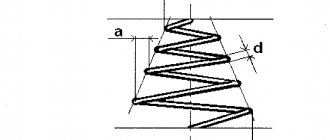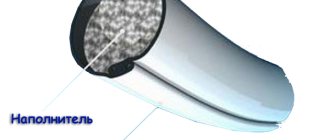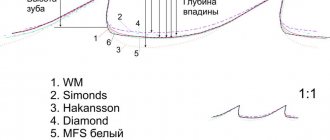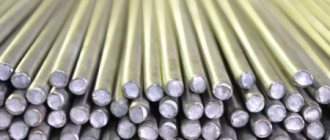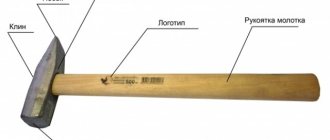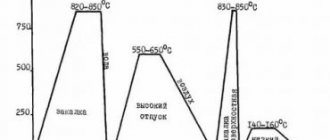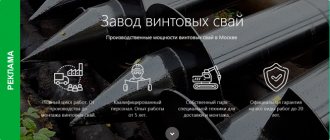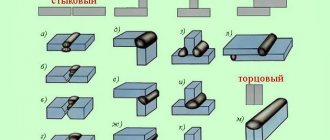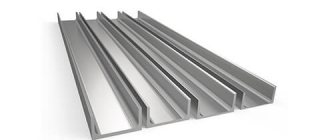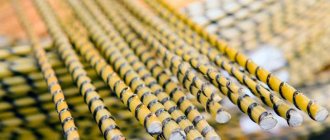Wire rod is a type of long metal thread with a rounded cross-section with a diameter of 5 to 14 mm. It is made from low-, medium- and high-carbon steels, as well as alloy and non-ferrous alloys. But steel wire rod finds the most extensive and widespread use. It is produced by hot rolling, which causes the presence of a small amount of process scale on its surface. And for convenient storage and transportation, it is rolled into buns.
Characteristics of copper wire
Distinctive features: high electrical and thermal conductivity. Due to its high ductility, copper wire is an indispensable material as a base for electrical devices and wires. Also, copper wire has good flexibility and is resistant to breakage. Not exposed to the external environment, resistant to corrosion.
The technical characteristics of copper wire vary depending on the brand (M1, M2, M3).
Types of copper wire:
— by purpose: general, for low-temperature thermocouples, crushers;
— in shape: square (or rectangular), hexagonal, round cross sections;
- by width or diameter of the section;
— according to the state of the material: hard, semi-hard, soft (as well as all of the above states with increased plasticity);
— in terms of production accuracy: normal, increased;
— by type of cladding: coatings with tin, silver, nickel;
— by brand: M1, M2, M3.
In turn, solid wire, despite its strong structure, does not have high flexibility. Soft copper wire is easy to bend. The MM marking material is the main part for conductive cables and constituent conductors of different sections. Copper wire becomes soft after the annealing operation.
The color of copper wire is golden-red or reddish-pink. The copper surface shines until oxidation (reaction upon contact with air), after which a film of oxides forms and the shine fades.
The surface must be free of cracks, nicks, delaminations, scratches, dents and other defects with a depth greater than the maximum deviation. Drips and stains of technological lubricant, reddened surface are allowed.
The metal products market also offers special types of copper wire:
— MS wire has a special set of properties and is intended for communication lines over the air;
- enameled: MME (soft enameled copper), MTE (hard enameled copper);
— grades of oxygen-free copper wire: MMB (soft) and MTB (hard).
Rolled copper of this type can be produced either from pure copper or clad with coatings of Sn, Ni, Ag. Oxidation resistance, resistance at low or high temperatures (up to 750 ºС), anti-corrosion properties, combines copper and nickel wire. The use of Ni and Ag for cladding allows the production of high-quality products used in: aviation and space defense, electronics, television communications and other fields.
The strength properties of copper-based wire are an order of magnitude higher than those of aluminum.
Scope of application of steel wire rod
Most of all, steel wire rod is used for reinforcing monolithic concrete structures. For example, in the manufacture of reinforcement cages, stacked clamps square, round or with a rectangular shape are made directly from wire rod. With the help of reinforcement cages, monolithic columns, crossbars, belts, overhead lintels and strip foundations are reinforced. In addition to using wire rod in frames, it is also used in the manufacture of welded reinforcing mesh with a cell of 100x100 or 150x100 mm. Reinforcing mesh is used to reinforce monolithic planes, for example, concrete floors, interfloor slabs or screeds.
Unlike wire rod, reinforcement has higher strength, so it is the main element of concrete structures. You can read more about reinforcement, its types and characteristics in a special article: what is reinforcement; how to choose it; characteristics, bending and knitting of reinforcement.
Steel wire rod is also used when laying load-bearing walls or partitions made of brick, cauldron, cinder block, foam block or gas block. Depending on the specific stone used for masonry, steel wire is inserted into every 2 - 4 row of mortar, thereby increasing the overall strength of the masonry.
Steel wire is quite often used on its own as an installation material. For example, when installing wooden poles for power lines, first a concrete pile with a square cross-section - a stepson - is installed in the ground, and then a vertical wooden pole is tied to the concrete pile with wire rod. Quite often, wire rod is used to tie the Mauerlat to a concrete belt when constructing a gable roof.
Using wire rod when installing wooden poles
aluminum wire rod
Related Posts via Categories
- Copper wire against late blight - reliable disease prevention
- Copper wire - from electrical appliances to jewelry
- Weight of steel, copper and aluminum wire - tables and calculation formulas
- Copper sheet is a popular rolled product with special properties.
- Copper grades - production features and main properties!
- Welding wire for semi-automatic machines - choosing the right working tool
- Stainless steel welding wire – for corrosion-resistant seams
- How to choose and how much tying wire to use for tying reinforcement?
- Copper and its main alloys
- Application of flux-cored wire for semi-automatic machines
Tips for choosing
Typically, factories and large industrial enterprises buy wire rod from non-ferrous types of metal. For construction or installation, a steel type of wire is purchased. When purchasing, you need to know that the product must be sold in skeins. The skeins usually include 1 or 2 cores. It is also worth knowing that with a two-core skein, there must be 2 labels on the product.
From these designations we can conclude that the product has normal strength and a diameter of 5 mm. The product was produced using accelerated cooling. This product fully complies with GOST.
In addition to studying information from the manufacturer, you need to conduct a visual inspection of the cores. The product should not have scale, cracks, or burrs. A defective product is one that has voids, bubbles and lack of carbon
And also you should not ignore the general color of the wire rod. If the color is uniform, then you can be sure that the wire will be strong and flexible along its entire length
For various jobs in which wire rod can be used, there are specific requirements for its properties. When buying wire rod, you must evaluate the length and size of its cross-section; the cost of wire rod per 1000 kg directly depends on these characteristics. The cost of a product is also influenced by the material from which it is made.
Copper wire is considered the most expensive, aluminum wire is 2 times cheaper, steel wire is the most inexpensive, the cost of which does not exceed 30 rubles. for 1000 g. If desired, the consumer will be able to buy a coil of wire rod, which contains from 160 to 500 kg. And also in small retail trade you can find skeins with lower weight.
For more information about the production of wire rod, see the video below.
How to buy wire rod?
- If you want to select and buy wire rod in our RUMETALL online store, we have prepared detailed information for you on size, weight, price options, photos and all available characteristics in the product cards.
- Delivery in Moscow and the region is carried out by vehicles with a carrying capacity from 500 kg to 10 tons. Detailed information in the corresponding section
- RUMETALL sells construction mounting fittings wholesale and retail at affordable prices. There is a system of discounts and bonuses for regular customers.
Basic provisions of GOST
Basic physical properties and quantities in the form of technical parameters, chemical composition, testing methods and geometric dimensions are determined by GOST R-53803-2010. All copper wire rod after 2010 is produced in Russia in accordance with this GOST.
The standard defines the nominal standard sizes of sections adopted today in Russia. This is wire and copper rod with a thickness of 8 to 23 mm. Tolerances for a wire of 8-14 mm can be of the order of 0.4 mm, and for a rod with a cross-section from 15 to 23 mm - 0.6 mm.
Existing standards divide copper wire rod into types, the marking of which indicates the method by which it was manufactured. The methods determine the purity of the metal, on which its price directly depends. Thus, the KMB marking means oxygen-free wire rod. But it also contains subspecies Moo with 99.99% Cu, M1 - 99.9%, M4 - 99.0%, where the numbers indicate the Cu content as a percentage. Moo is a cathode electrolytic grade that is completely devoid of oxygen and has the highest electrical conductivity with the lowest possible resistance. and the cost of a kilogram of such copper is the highest. But the KMor marking informs that this copper wire rod is made from refined waste and copper scrap, that is, this wire rod contains copper of different grades.
Explanation of markings
The “M” in front of the metal purity index simply means “copper.” Two “zeros” (00) – high purity. One zero (0) is just blank. With numbers 1,2,3 – technically clean. The last element of the markings is usually a letter index, indicating the method in which the metal was cast: K - cathode. U – cathode remelted. Oxygen-free copper is designated by the letter B, deoxidized copper by P, and deoxidized copper by introducing phosphorus into the melt will be marked accordingly by the letter F.
In total, about 20 grades of this metal are produced in Russia, intended for use in various industries.
An intermediate position between these grades is occupied by copper rod marked KM.
The GOST adopted in 2010 allows for the production of copper wire rod of other nominal sizes, if such was the customer’s requirement.
There is also a list of chemical elements that are strictly regulated by GOST according to their maximum values in the composition of copper for industry. These are bismuth, arsenic, sulfur, antimony, lead, tellurium, selenium, silver, iron and oxygen. Their share in the total mass of a copper ingot or wire rod should not exceed values from 0.001 to 0.005%. The most harmful to the quality of copper is the content of bismuth and lead in it, since these substances make copper brittle with even slight heating. Therefore, the mass percentage of these elements should not exceed 0.001%. The presence of sulfur and oxygen in copper improves its ability to be cut, but sulfur at the same time impairs the ductility of this metal.
The content of substances such as phosphorus, cobalt, silicon, nickel, manganese, chromium, tin, zinc and aluminum is not regulated by GOST.
There may be dents, scratches, gouges and scratches on the surface of the drawn wire, but if their dimensions do not exceed 0.2 mm, the material is suitable for production. An exception is made only for high-precision technologies.
Product requirements
But in some cases additional requirements are put forward:
For finished products, twisting and unwinding tests are provided.
- Wire with a cross-section of 16 mm or more must withstand 3 cycles of twisting and unwinding. With a cross section from 13 to 16 mm – 5 cycles. And with a cross section from 8 to 13 - 10.
- The elongation of the wire rod at break must be at least 35%.
- The value of temporary resistance in megapascals must be expressed as a number of at least 160.
Additional tests may be carried out at the request of the client. So, these may be tests for hydrogen embrittlement for grades KMB and for helix elongation - such a test may be required for grades KM and KMor.
Although quite standard and even high-quality copper can fall into the “copper scrap” category. This can happen when:
- The percentage of metal oxidation in the coil exceeded the weight measurement method of 0.01.
- The presence of mechanical defects in the form of tears, notches and dents, if cleaning could not eliminate these defects.
- Exceeding the shelf life of the coil of wire rod for more than 3 months (after the expiration of this period, a comprehensive check of all parameters of the coil is required, and if at least one of them does not comply, even refined copper with a purity of 99.99% can be considered scrap). Therefore, the production of high-purity cathode electrolytic copper grades is always done for a specific customer and in the case of only 100% prepayment, with a warning about the possible consequences of failure to pick up the ordered wire rod on time.
Production of copper rod
Copper wire rod is produced using the technology of drawing metal through rolling rollers on special mills, where they make profiled material (wire) of different thicknesses from the wire rod.
When passing through the rollers, the copper rod, which is transformed into wire under their influence, is subjected to strong heating using eddy induction currents or in a gas flame. After passing through the rollers, the hot wire is placed into coils using devices called coilers. At the same time, the material is cooled. In slow-running coilers and on thin wire, such cooling occurs naturally; when quickly winding the finished product, forced air flow is used.
Because of the preheating during the drawing phase, the process is called hot rolling.
Wire rod production technology
Wire rod production is carried out on metal rolling machines using rolling and drawing methods. Initially, a square of carbon steel with a cross-section of 10x10 mm is launched into the shafts of the rolling machine. Several shafts installed in series compress the steel workpiece, giving it a circular cross-section of a given diameter. At the same time, during rolling and the impact of the shafts on the workpiece, it itself heats up due to the friction force. Upon completion of rolling, the wire of the required diameter is fed into the installation, which twists the wire rod into a ring. After twisting the ring, it is transferred by special automated mechanisms to the cooling zone.
Wire rod production technology: rolling and drawing
Although the wire rod is hot-rolled metal, I cool it in three ways:
- УО1 – accelerated single-stage cooling;
- УО2 – two-stage accelerated cooling;
- VO – natural air cooling.
Natural air cooling can be carried out both in the workshop on special pallets and outdoors at temperatures up to +10 degrees. In essence, in this way, a red-hot wire rod is obtained, which has good strength and at the same time bends easily. Wire made using accelerated cooling - УО1 and УО2, at the stage of its cooling is placed in special chambers, which are equipped with forced powerful hoods. As a result of rapid cooling, semi-hardened and tempered wire is obtained, relatively speaking.
Manufacturers
Manufacturers of wire rod strictly monitor the quality of their products, so they are produced in accordance with GOST standards. Currently, a large number of brands of this rolled metal are known.
There are many popular wire rod manufacturers:
- Liepajas Metalurgs – Latvia;
- TECRUBE – Azerbaijan;
- "Absolute" - Russia;
- Alkor Trading Company – Russia;
- "Amurstal" - Russia;
- "Areal" - Russia;
- "Balcom" - Russia;
- Belarusian Ministry of Health;
- VISMA - Belarus;
- "Danko" - Ukraine;
- Dnepropetrovsk MZ;
- "Dneprospetsstal" - Ukraine.
This list of companies that are engaged in the production and sale of wire rod from copper, steel, and aluminum cannot be called complete; there are many more of them in Russia and the CIS countries.
Production of fittings
The fittings are produced in factories, in specially equipped workshops. Automation and mechanization make it possible to obtain in a short time a large amount of the necessary material with different characteristics. The steel used in its preparation is supplied by mechanized transport and special cranes. After cutting, welding, and other work using special highly specialized devices, the products are sent to storage areas. Special places are allocated for this.
Enterprises specializing in the production of fittings launch 2 production lines:
- material supplied in coils;
- Manufactured from bar steel.
Packaging and labeling
Copper wire rod is supplied strictly in one integral piece, wound into coils, without breaks or breaks along the entire length. The weight of the coil is agreed with the buyer. There should be no tangling or overlap of turns - this will interfere with the smooth unwinding of segments of the required length. The winding density of the wire rod in the coil must ensure and guarantee its integrity during packaging and delivery to the place of consumption.
To preserve its shape, the coil must be tied in at least three places around the circumference with a special steel or nylon tape. In addition to dressing, packaging can be made to protect the coil of wire rod from precipitation and other adverse influences. Packaging is a mandatory procedure that is done by default, but it can be omitted if the customer so desires.
The main differences between A1 reinforcement, wire rod and steel circle
These types of rolled metal have a number of significant differences:
- The steel circle, compared to A1 reinforcement and wire rod, is a more even and durable product.
- Wire rod and A1 reinforcement do not have the same flexibility as a steel circle. With slight bending, it is able to restore its shape.
- A steel circle that complies with established standards is distinguished by its section accuracy.
- The diameter of a steel circle can reach 40 cm. Reinforcement and wire rod with this indicator are not produced.
- Wire rod and A1 reinforcement, which can be purchased at a lower cost than a steel circle, are among the cheapest types of rolled metal.
In order to more accurately compare all the differences between the above-mentioned types of steel products, you should study the features of each of them in more detail.
Wire M1
M1 brand wire is considered the highest quality and most expensive. The purity of the copper alloy used for its production is 99.9%. Composition: Cu – 99.9%, impurities (such as Pb, Fe, Ni, S, As, Sb, Bi, Sn) – not higher than 0.1%. According to physical characteristics, there are: hard (M1T), soft (M1M). Other types of M1 wire: oxygen deoxidized (M1P), oxygen-free (M1B), phosphorus deoxidized (M1F), cathode (M1K).
Wire M1 differs from other rolled products (M2, M3) by increased performance characteristics, due to the minimum content of impurities in the material. It has good thermal and electrical conductivity. Bends well while maintaining strength properties. Nice appearance.
This wire is most often used in such areas as aircraft and shipbuilding, and electric power. They produce cords, cables, thermocouples, wires, and high-tech cryogenic equipment.
General information about copper
Copper. The name in the periodic table of elements is Cuprum (Cu). Serial number – 29. Group I or secondary subgroup in the table, in its 4th period. The name comes from the name of the island of Cyprus, from where it was exported to the ancient city-states of the Mediterranean for use in everyday life, on the farm and in war.
In the metallic phase it is a pink-red substance, soft and malleable when heated to 700-800⁰C. Melts at a temperature of 1084.5⁰ C. Can be processed by pressure both cold and hot, as well as all types of soldering and casting into any shape, as well as cutting. After melting, when the melt temperature reaches 2,560⁰С, the liquid metal begins to boil.
The chemical composition of impurities and the method of obtaining the metal also affects such properties of copper as thermal conductivity, specific heat, resistivity and associated electrical conductivity, elasticity, hardness and tensile strength.
Copper grades
The classification of copper in Russia is adopted according to GOST 895-2001 and R-53 803-2010 “Copper. Stamps."
When cathode grades of copper are used in electrically conductive networks or in high-precision equipment, they are often divided into subtypes MooK (cathode) and MooB (oxygen-free), having a purity of 99.99 (the percentage of impurities of foreign substances is 0.001).
The emphasis on oxygen-free copper is not in vain: oxygen in the metal is not only an undesirable oxidizing agent, but also significantly reduces the ductility and strength of the metal. No less harmful is the presence of hydrogen molecules in the atmosphere, which, with significant heat treatment of copper (and not necessarily its melt), diffusely penetrates deep into the metal into its upper boundary layer and reduces copper oxide to pure metal and water. Molecular water, when heated repeatedly, is capable of producing local high pressure in the crystal lattice, which can form breaks, porosity and microcracks in the monolith.
These phenomena are especially harmful if high-temperature soldering or welding of copper surfaces is done, since the strength of the joints is reduced.
Hydrogen disease
However, “hydrogen disease” is typical only for high-temperature welding and soldering. With “soft” soldering, below 400⁰С, the phenomenon of hydrogen embrittlement can be neglected; hydrogen atoms below 400 degrees do not diffuse deeply into the metal - and the more the soldering temperature drops below 400⁰С, the less the influence of this metal reducer from oxides.
To prevent oxidation or the influence of hydrogen, the metal is melted
- In a vacuum.
- In an atmosphere of inert gases (argon).
- Under a layer of charcoal.
Although the most common way to prevent “hydrogen disease” is to introduce into the metal during melting an additive that binds oxygen and does not affect the physical parameters of the metal after casting or broaching. Phosphorus is used as an additive.
The quality criteria used in Russia and the EU countries are almost the same. The difference often lies in the requirements for controlling the quantity and quality of permissible or specially introduced impurities. Thus, Russian M1F and Cu-DHP, although they are analogues, have different impurities. In practice, this is expressed in the fact that in Russia the control of impurities is stricter, and the chemical composition of the metal is more stable in its physical characteristics. In M1F, it is under no circumstances allowed to use scrap during smelting, especially from refined copper fragments. This is the norm in Cu-DHP.
Strength can be characterized by three states of the same grade: at a tensile strength of 210 MPa, copper is “soft”, at 250 MPa it is semi-hard, and at 280 MPa it is hard. Accordingly, M (foreign analogue of R 220), PT (R 250) and T (R – 280). Although, in addition to T, there are also more durable (solid) states of copper. Copper can even be quenched as a way to increase hardness - to do this, it is heated to 600⁰C and slowly cooled.
Accounting for loads during reinforcement
As a rule, concrete structures have significant weight. Acting with their entire mass, they contribute to the appearance of cracks, shrinkage, and subsequently destruction. Buildings constructed of concrete, but reinforced with steel reinforcement, take the weight load on themselves, preventing the occurrence of such errors.
Different scientists at different times were engaged in research in order to obtain new technology that would allow construction to be carried out safely. The results of experiments and calculations showed the importance of not only the quantitative ratios of reinforcement bars, but also their spatial location in the overall concrete mass, thickness, and placement relative to each other. The direct execution of calculations depends on these data.
Emerging technologies allow the use of new technologies, but the popularity and relevance of reinforcement has remained stable over the years.
Reinforcement is used in construction at stages from “A” to “Z” during the construction of:
- foundations;
- walls;
- floors;
- monolithic structures;
- in the construction of bridges, tunnels;
- expensive
The active use of metal rods leads not only to constant demand for this type of product, but also to the development of new types of rods. Now you can find reinforcement with different compositions, types, and strength levels.
In the modern interpretation, the reinforcement began to be called whips, on which notches were applied. These small changes make it possible to obtain a tighter adhesion of the mortar and reinforcement, thereby strengthening the integral structure and ensuring the overall reliability of the building.
If wire or thin whips are used, as a rule they are selected and produced smooth.
Developments in new technologies also include rods made of composite materials. This is fiberglass, basalt. They are bound with a resin-based mass. Without compromising on strength and reliability, these materials provide long service life.
Application of copper wire
Due to its high electrical conductivity, copper wire is widely used in such areas as construction, electric power, automotive and aircraft manufacturing, etc. In most cases, using copper wire (with a diameter of up to 8 mm), electrically conductive conductors (wires, cords, cables) are produced. Copper bars are used in electrical engineering, cryogenic equipment, transformer substations, and are also used as motor windings.
Main applications of copper wire:
— galvanization — if it is necessary to coat the surface of small-volume products, use copper wire;
- construction - often used for decorative cladding, plastering, or as a material for reinforcement and shielding;
- welding - welding thin sheet metal;
- light industry - used for frames when sewing soft toys, also handmade crafts are made;
- costume jewelry - jewelers use it to make jewelry, jewelry;
- electrical engineering - in this area, copper wire has the greatest application, it is used for the production of almost all types of electrical conductors, and serves as a winding in engines;
- agriculture - used to accelerate the maturation of plants;
- medicine - copper wire is used in folk and scientific medicine.
Steel circle
This is a round type of rolled metal, which is widely used in the production of metal structures and pipes, washers, rivets, as well as other elements for parts of varying complexity. According to the manufacturing method there can be two types:
– cold rolled;
– hot rolled.
Also, the steel circle has found application in the manufacture of various power and decorative elements. It is indispensable in creating protective components for stairs and balconies.
The production of the circle is carried out using different types of steel:
– low alloy. Products are created in lengths from 2 to 12 meters;
- alloyed. The resulting length of products ranges from 2 to 6 meters;
– highly alloyed. A product made from this raw material can be from 1 to 6 meters long;
– complex alloyed. This circle is distinguished by high performance qualities (resistance to corrosion reactions, high strength).
A steel circle can be subject to a galvanizing procedure, which allows it to acquire all the characteristics required when organizing grounding systems.
